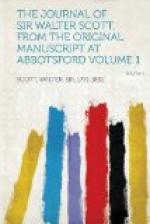Just as we were sitting down to dinner, Cadell burst in in high spirits with the sale of Napoleon[540] the orders for which pour in, and the public report is favourable. Detected two gross blunders though, which I have ordered for cancel. Supped (for a wonder) with Colin Mackenzie and a bachelor party. Mr. Williams[541] was there, whose extensive information, learning, and lively talent makes him always pleasant company. Up till twelve—a debauch for me nowadays.
June 30.—Redd up my things for moving,[542] which will clear my hands a little on the next final flitting. Corrected proof-sheets. Williams told me an English bull last night. A fellow of a college, deeply learned, sitting at a public entertainment beside a foreigner, tried every means to enter into conversation, but the stranger could speak no dead language, the Doctor no living one but his own. At last the scholar, in great extremity, was enlightened by a happy “Nonne potes loqui cum digitis?”—said as if the difficulty was solved at once.
Abbotsford.—Reached this about six o’clock.[543]
[Illustration: MAP OF ABBOTS FORD FROM THE ORDNANCE SURVEY 1858.]
FOOTNOTES:
[527] Sheridan’s Critic, Act I. Sc, 1.
[528] “No sooner had the Sun uttered these words than Fortune, as if she had been playing on a cymbal, began to unwind her wheel, which, whirling about like a hurricane, huddled all the world into an unparalleled confusion. Fortune gave a mighty squeak, saying, ’Fly, wheel, and the devil drive thee.’”—Fortune in her Wits, Quevedo. English trans. (1798), vol. iii. p. 107.
[529] Burns: “On a Scotch Bard, gone to the West Indies.”
[530] Vivian Grey, by Benjamin Disraeli, was published anonymously in 5 vols. 12mo, 1826-7.
[531] If the reader turns to December 18, 1825, he will see that this is not the first allusion in the Journal to his “first love,”—an innocent attachment, to which we owe the tenderest pages, not only of Redgauntlet (1824), but of the Lay of the Last Minstrel (1805), and of Rokeby (1813). In all these works the heroine has certain distinctive features drawn from one and the same haunting dream. The lady was “Williamina Belches, sole child and heir of a gentleman who was a cadet of the ancient family of Invermay, and who afterwards became Sir John Stuart of Fettercairn.” She married Sir William Forbes in 1797 and died in 1810.—Life, vol. i. p. 333; Shairp’s Memoirs of Principal Forbes, pp. 4, 5, 8vo, London, 1873, where her portrait, engraved from a miniature, is given.
[532] Hugh Cleghorn had been Professor of Civil History in St. Andrews for ten years, afterwards becoming tutor to the Earl of Home, and subsequently employed by our Government in various foreign missions. A glimpse of his work is obtainable in Southey’s Life, of Dr. Andrew Bell. Mr. Cleghorn died in 1833, aged 83.




